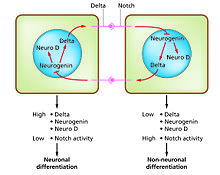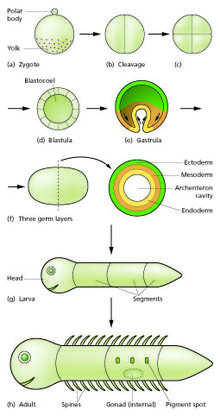Developmental biology
| Part of a series on |
| Biology |
|---|
Developmental biology is the study of the process by which animals and plants grow and develop. Developmental biology also encompasses the biology of regeneration, asexual reproduction, metamorphosis, and the growth and differentiation of stem cells in the adult organism.
Perspectives
The main processes involved in the
.- transcription factors.
- Cell differentiationrelates specifically to the formation of functional cell types such as nerve, muscle, secretory epithelia, etc. Differentiated cells contain large amounts of specific proteins associated with cell function.
- Morphogenesis relates to the formation of a three-dimensional shape. It mainly involves the orchestrated movements of cell sheets and of individual cells. Morphogenesis is important for creating the three germ layers of the early embryo (ectoderm, mesoderm, and endoderm) and for building up complex structures during organ development.
- Tissue growth involves both an overall increase in tissue size, and also the differential growth of parts (allometry) which contributes to morphogenesis. Growth mostly occurs through cell proliferation but also through changes in cell size or the deposition of extracellular materials.
The development of plants involves similar processes to that of animals. However, plant cells are mostly immotile so morphogenesis is achieved by differential growth, without cell movements. Also, the inductive signals and the genes involved are different from those that control animal development.
Generative biology
Generative biology is the generative science that explores the dynamics guiding the development and evolution of a biological morphological form.[1][2][3]
Developmental processes
Cell differentiation

Regeneration
Embryonic development of animals

The sperm and egg fuse in the process of fertilization to form a fertilized egg, or
Mouse
Morphogenetic movements convert the cell mass into a three layered structure consisting of multicellular sheets called

Morphogenetic movements not only change the shape and structure of the embryo, but by bringing cell sheets into new spatial relationships they also make possible new phases of signaling and response between them. In addition, first morphogenetic movements of embryogenesis, such as gastrulation,
The whole process needs to be coordinated in time and how this is controlled is not understood. There may be a master clock able to communicate with all parts of the embryo that controls the course of events, or timing may depend simply on local causal sequences of events.[30]
Metamorphosis
Developmental processes are very evident during the process of metamorphosis. This occurs in various types of animal. Well-known examples are seen in frogs, which usually hatch as a tadpole and metamorphoses to an adult frog, and certain insects which hatch as a larva and then become remodeled to the adult form during a pupal stage.
All the developmental processes listed above occur during metamorphosis. Examples that have been especially well studied include tail loss and other changes in the tadpole of the frog Xenopus,[31][32] and the biology of the imaginal discs, which generate the adult body parts of the fly Drosophila melanogaster.[33][34]
Plant development
Plant development is the process by which structures originate and mature as a plant grows. It is studied in plant anatomy and plant physiology as well as plant morphology.
Plants constantly produce new tissues and structures throughout their life from meristems[35] located at the tips of organs, or between mature tissues. Thus, a living plant always has embryonic tissues. By contrast, an animal embryo will very early produce all of the body parts that it will ever have in its life. When the animal is born (or hatches from its egg), it has all its body parts and from that point will only grow larger and more mature.
The properties of organization seen in a plant are emergent properties which are more than the sum of the individual parts. "The assembly of these tissues and functions into an integrated multicellular organism yields not only the characteristics of the separate parts and processes but also quite a new set of characteristics which would not have been predictable on the basis of examination of the separate parts."[36]
Growth
A
Once the embryo
In addition to growth by cell division, a plant may grow through cell elongation.[39] This occurs when individual cells or groups of cells grow longer. Not all plant cells will grow to the same length. When cells on one side of a stem grow longer and faster than cells on the other side, the stem will bend to the side of the slower growing cells as a result. This directional growth can occur via a plant's response to a particular stimulus, such as light (phototropism), gravity (gravitropism), water, (hydrotropism), and physical contact (thigmotropism).
Plant growth and development are mediated by specific plant hormones and plant growth regulators (PGRs) (Ross et al. 1983).[40] Endogenous hormone levels are influenced by plant age, cold hardiness, dormancy, and other metabolic conditions; photoperiod, drought, temperature, and other external environmental conditions; and exogenous sources of PGRs, e.g., externally applied and of rhizospheric origin.
Morphological variation
Plants exhibit natural variation in their form and structure. While all organisms vary from individual to individual, plants exhibit an additional type of variation. Within a single individual, parts are repeated which may differ in form and structure from other similar parts. This variation is most easily seen in the leaves of a plant, though other organs such as stems and flowers may show similar variation. There are three primary causes of this variation: positional effects, environmental effects, and juvenility.
Evolution of plant morphology
Transcription factors and transcriptional regulatory networks play key roles in plant morphogenesis and their evolution. During plant landing, many novel transcription factor families emerged and are preferentially wired into the networks of multicellular development, reproduction, and organ development, contributing to more complex morphogenesis of land plants.[41]
Most land plants share a common ancestor, multicellular algae. An example of the evolution of plant morphology is seen in charophytes. Studies have shown that charophytes have traits that are homologous to land plants. There are two main theories of the evolution of plant morphology, these theories are the homologous theory and the antithetic theory. The commonly accepted theory for the evolution of plant morphology is the antithetic theory. The antithetic theory states that the multiple mitotic divisions that take place before meiosis, cause the development of the sporophyte. Then the sporophyte will development as an independent organism.[42]
Developmental model organisms
Much of developmental biology research in recent decades has focused on the use of a small number of
Plants
- Thale cress (Arabidopsis thaliana)[43]
Vertebrates
- Frog: Good embryo supply. Especially suitable for microsurgery.
- Zebrafish: Danio rerio.[46] Good embryo supply. Well developed genetics.
- Chicken: Gallus gallus.[47] Early stages similar to mammal, but microsurgery easier. Low cost.
- Mouse: Mus musculus.[48] A mammal[43] with well developed genetics.
Invertebrates
- Fruit fly: Drosophila melanogaster.[49] Good embryo supply. Well developed genetics.
- Nematode: Caenorhabditis elegans.[50] Good embryo supply. Well developed genetics. Low cost.
Unicellular
- Algae: Chlamydomonas[43]
- Yeast: Saccharomyces[43]
Others
Also popular for some purposes have been
See also
- Blastocyst
- Body plan
- Cell signaling
- Cell signaling networks
- Embryology
- Enhancer
- Fish development
- Gene regulatory network
- Ontogeny
- Plant evolutionary developmental biology
- Promoter (biology)
- Signal transduction
- Synthetic biology
- Teratology
References
- ISBN 978-0-521-35451-6.
- ^ "Generative Biology: Designing Biologic Medicines with Greater Speed and Success". Amgen. June 7, 2022. Retrieved 5 April 2024.
- ^ "Generative Biology: Learning to Program Cellular Machines". NIH. Mar 15, 2024. Retrieved 5 April 2024.
- PMID 17320508.
- S2CID 1595885.
- (PDF) from the original on 2017-10-27.
- PMID 20418862.
- ^ Carlson BM (2007). Principles of Regenerative Biology. Burlington MA: Academic Press.
- PMID 17234176.
- ^ S2CID 1320382.
- PMID 21566185.
- PMID 18030418.
- S2CID 13158705.
- ^ Slack JM (2013). "Chapter 20". Essential Developmental Biology. Oxford: Wiley-Blackwell.
- PMID 12941269.
- ^ PMID 23223451.
- PMID 20595612.
- ^ Steven DH, ed. (1975). Comparative Placentation. London: Academic Press.
- PMID 23801439.
- .
- S2CID 21477124.
- S2CID 1805261.
- PMID 15261656.
- PMID 18952908.
- PMID 1293230.
- PMID 24281726.
- PMID 36531949.
- S2CID 7399128.
- ^ O'Farrell PH (2003). "How metazoans reach their full size: the natural history of bigness.". In Hall MN, Raff M, Thomas G (eds.). Cell Growth: Control of Cell Size. Cold Spring Harbor Laboratory Press. pp. 1–21.
- S2CID 29029979.
- S2CID 84081060.
- PMID 17449026.
- ^ Cohen SM (1993). "Imaginal Disc Development.". In Bate M, Martinez-Arias M (eds.). The Development of Drosophila melanogaster. Cold Spring Harbor Press.
- PMID 14550411.
- PMID 14505363.
- ^ Leopold AC (1964). Plant Growth and Development. New York: McGraw-Hill. p. 183.
- S2CID 5833219.
- PMID 15832381.
- PMID 30012836.
- ^ Ross SD, Pharis RP, Binder WD (1983). "Growth regulators and conifers: their physiology and potential uses in forestry.". In Nickell LG (ed.). Plant growth regulating chemicals. Vol. 2. Boca Raton, FL: CRC Press. pp. 35–78.
- from the original on 2016-06-02.
- PMID 22232763.
- ^ S2CID 13397345.
- ^ Nieuwkoop PD, Faber J (1967). Normal table of Xenopus laevis (Daudin). North-Holland, Amsterdam.
{{cite book}}: CS1 maint: location missing publisher (link) - PMID 21963197.
- PMID 21763608.
- S2CID 5489431.
- ^ Behringer R, Gertsenstein M, Vintersten K, Nagy M (2014). Manipulating the Mouse Embryo. A Laboratory Manual (Fourth ed.). Cold Spring Harbor, NY: Cold Spring Harbor Laboratory Press.
- S2CID 195368351.
- ^ Riddle DL, Blumenthal T, Meyer BJ, Priess JR (1997). C.elegans II. Cold Spring Harbor, NY: Cold Spring Harbor Laboratory Press.
- )
- PMID 21558365.
- PMID 21801016.
- PMID 25033469.
- ^ Weigel D, Glazebrook J (2002). Arabidopsis. A Laboratory Manual. Cold Spring Harbor, NY: Cold Spring Harbor Laboratory Press.
Further reading
- ISBN 9780197574591.
- Slack JM (2013). Essential Developmental Biology. Oxford: Wiley-Blackwell.
- Wolpert L, Tickle C (2011). Principles of Development. Oxford and New York: Oxford University Press.
